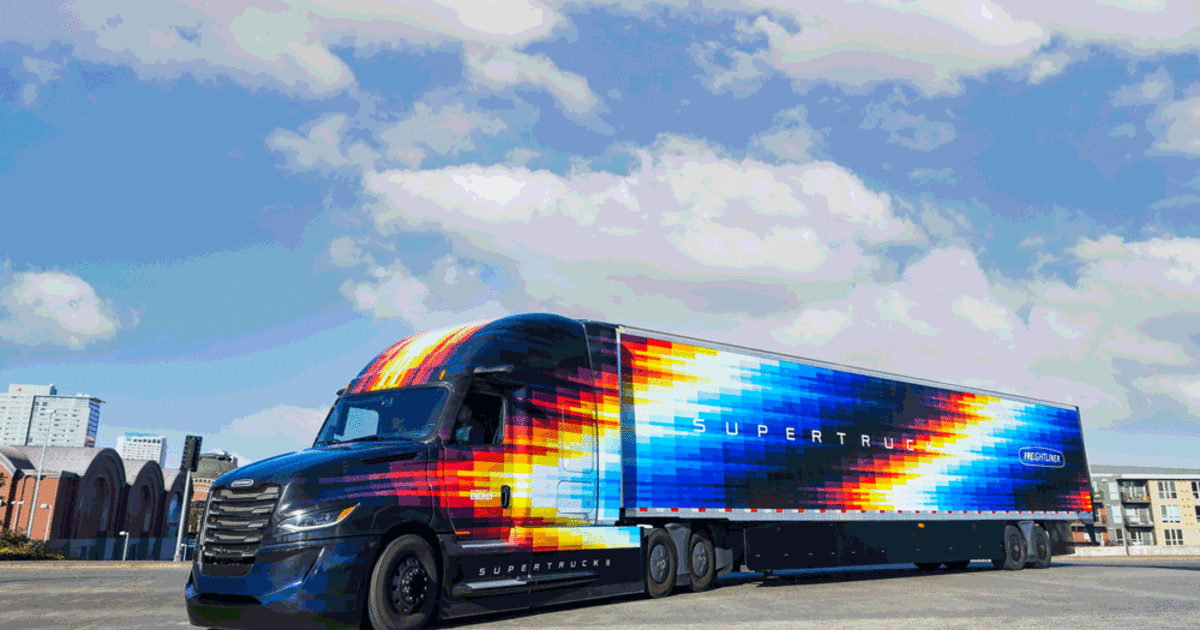
LAS VEGAS—Daimler Truck North America unveiled its SuperTruck II Wednesday, showing off an efficient diesel big rig intended to demonstrate fuel-saving technologies that can be deployed as the trucking industry pivots to zero-emission vehicles.
The sleek cab, painted in a pixelated rainbow livery to evoke a sense of effortless motion, is more of a proof-of-concept vehicle rather than the typical pie-in-the-sky concepts common in the auto industry.
“We focused on technologies and ideas that could be realistically implemented. We don’t do science projects at DTNA,” said Daimler Truck North America CEO John O’Leary.
The concept truck is based on Daimler’s Freightliner Cascadia model, which with nearly 40 percent of the market is the leading seller among Class 8 trucks in the U.S.
The project’s aim is to develop a tractor-trailer combination that demonstrates advances in aerodynamics, diesel engine technology, tire rolling resistance and other systems to dramatically increase the fuel efficiency of a Class 8 big rig.
Some will likely find their way into future Cascadias.
“The research and development we have done here is creating tools that we can later pull out of the toolbox and use,” said Derek Rotz, Daimler’s U.S. head of advanced engineering.
Daimler said the truck runs at about 12 mpg. The typical diesel Class 8 truck gets about 6.2 mpg, according to the North American Council for Freight Efficiency.
Although California, parts of Europe and other regions are forcing a gradual transition to zero-emission trucks, O’Leary said diesel would endure as the predominant fuel choice for the foreseeable future because it suits 100 percent of all applications.
“It remains the most cost-effective and efficient way to move goods and people,” he said. But truck manufacturers can still make significant efficiency gains.
The SuperTruck II is clearly recognizable as a Freightliner. The most visible change is the removal of the large elephant ear-style side view mirrors — long recognized as efficiency killers — required on current trucks. Instead, the truck takes advantage of a program exemption allowing cameras and screens inside the cab granted by NHTSA.
Daimler said the change solves a major efficiency fault in current trucks and might improve the driver’s visibility. The company sees the camera system as a potential regulatory change.
Elsewhere, engineers redesigned the hood, bumper and chassis fairing to work with the Cascadia’s existing cab but now allow air to flow around the truck with less disturbance. They also changed the grille, air intakes and doors to improve aerodynamics. The truck features prototype low-rolling resistance tires from Michelin.
Daimler used other techniques to help the big rig glide smoothly through the air. The truck uses active side extenders and a roof spoiler system to counteract fuel-sucking turbulence between the cab’s end and the trailer’s start. The system shrinks that gap by up to 4 inches when it opens at highway speeds. A height control system lowers the truck just inches above the road to enhance its aerodynamics.
Daimler also swapped the 12-volt electrical system in standard Cascadias for a 48-volt electrical system with lithium ion batteries. That battery pack provides enough power to reduce parasitic drains from the air conditioning and other systems. The electric power steering also uses power from the battery pack.
The truck has an engine auto-off feature that advances what new consumer passenger cars do at signals and stops. Called EcoSail, the system automatically judges when power is not needed coasting down a hill and shuts the engine off. Features such as air conditioning and power steering remain in operation thanks to the battery-powered electric steering.
The truck builder also made powertrain improvements. The concept truck uses a prototype 13-liter engine from Daimler’s Detroit engine division. It has a two-stage turbo and interstage cooling system and is mated to a 13-speed overdrive transmission. It can achieve lower downspeeding — lowering the engine’s rpm — and also saves fuel by reducing drag.
Launched in 2016, the Department of Energy put up $20 million for Daimler’s SuperTruck II project. The company added $18 million. Michelin pitched in $1 million, and other research institutions added nearly another $1 million.
Other manufacturers, including Navistar, Volvo and Paccar are developing similar demonstration vehicles.
Achieving better efficiency is an industry goal. Fuel trails only labor and accounts for about 22 percent of the cost of heavy-duty trucking, according to the American Transportation Research Institute.
Commercial trucks consume about 24.5 percent of transportation fuels in the U.S., according to the U.S. Energy Information Administration, although they make up about 13 percent of vehicles on the road, according to S&P Global Mobility registration data.
Daimler could use the aerodynamic and other technology demonstrated in the SuperTruck II with different powertrains, the design team told Automotive News.
Already Daimler is selling electric eCascadia Class 8 tractors that work only with electric motors.
Daimler also started a SuperTruck 3 demonstration project following a $26 million Department of Energy award in 2021. The planned vehicle is a Class 8 hydrogen fuel cell electric truck with an expected range of 600 miles.
The goal is to design a zero-tailpipe-emissions Class 8 tractor that exceeds the performance of a diesel heavy-duty long-haul sleeper in range and efficiency without compromising the amount of cargo it can haul.
The SuperTruck grants are working to advance transportation technology, said Mike Roeth, executive director of the North American Council for Freight Efficiency, one of the program’s early advocates.
“SuperTruck 2 had a very specific focus on affordability of the technologies, and we will see the concepts show up in upcoming model year trucks as the OEMs meet ever-increasing GHG Phase 2 regulations,” Roeth said.
Daimler is a standalone truck builder following its December 2021 spinoff from the corporate parent of the Mercedes-Benz car business.